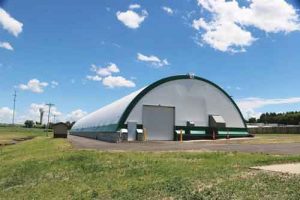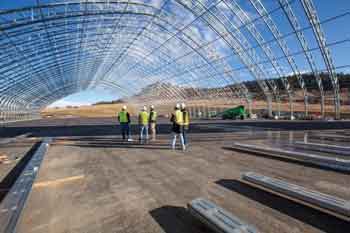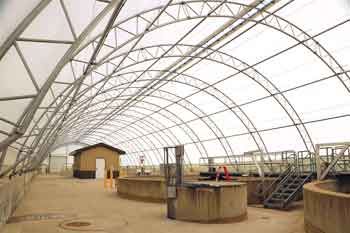Operations need to balance functionality, quality and price, while also keeping in mind future growth. A fabric structure can meet all these requirements and surpass expectations.
By Brett Bodzinski
There is no doubt that finding a building solution for a waste or recycling facility can be stressful. Perhaps the hardest part is predicting where a business will be in five to 10 years. If an operation is going to invest in a building, they are going to still want it to be serviceable and not outgrow it in a matter of years. Of course, there are some temporary structures that are cost-effective and will allow operations to get rid of them and upgrade as needed. Unfortunately, these often have cheap designs and are not made to withstand the harsh weather or the corrosive environments found on waste facilities. This less-than-ideal solution can create an unsafe workspace and can put businesses at risk for litigation.

Photos courtesy of ClearSpan Fabric Structures.
Operations need to balance functionality, quality and price, while also keeping in mind future growth. When taking this into account, fabric buildings are the ideal solutions, because, when designed by the right manufacturer, a fabric structure can meet all these requirements and surpass expectations.
What makes fabric structures so effective for growing waste and recycling facilities is the fact that they can be engineered and easily expanded on if and when business requires it. Let’s take a look at how fabric buildings can help waste and recycling businesses that are planning on growth, but then also take a step back and discuss how integrating a fabric structure can be beneficial to any recycling and waste facility.
Flexibility
Getting a structure that is strong enough to be permanent but can still be expanded upon is a difficult proposition for most building styles, but fabric structures allow this to be a possibility. The combination of some brand’s inherent design and flexible foundation means that quality and durability can be optimized without setting the structures’ footprint in stone both literally and figuratively. Today, fabric structures have come a long way in their design, and although they may be referred to as “tents”, they are much more comparable to more traditional building solutions.
A Strong Structural Base
Waste and recycling facilities should look for a structure that uses a truss arch or I-beam frame, and then to ensure the building provides the necessary strength, operations should also work with a manufacturer that can provide stamped engineered drawings upon request. These types of frames are often made from high-quality steel that ensures a strong structural base, and they can also be triple-galvanized. This is particularly important for waste and recycling facilities, as the internal environments can become corrosive as materials break down. Triple-galvanized steel can withstand a corrosive atmosphere without prematurely corroding, ensuring the frame lasts well into the future.
For those that need engineered drawings, these frame styles can be designed to meet any local building codes or regional weather requirements. Fabric buildings can even be constructed in places like Florida where the weather can become extreme in the fall months. A good fabric structure will have a strong manufacturer’s warranty, and those in the market should look for warranties in the 50-year range.

Expansion
So, these types of frames provide the required strength, but how can a building expand as business grows? This comes down to the frame’s natural design and the unique foundation options that can be matched with fabric buildings. The frame design of these structures is a row of arches that are usually all the same width. As business grows and the building needs to be expanded, businesses simply have to order more frame arches and the necessary cover material. The framing can then be lined up with the existing building and the cladding extended to cover the framing. This feature allows operations to not only expand the building, but also dial into the exact amount of space they want to increase the building by.
In order to expand, the structure’s foundation will obviously have to be flexible, and a traditional concrete foundation or pad is going to be difficult and costly to expand. Perhaps the best option for businesses that are expecting future expansion is a helical anchoring system. These systems are among the most versatile foundation options, and they drill directly into the ground, creating a strong and dependable foundation. Helical anchors require limited site preparation, allowing structures to be built just about anywhere. The arch frames sit directly on the helical anchors, and as more arches are added, so are helical anchors.
Another benefit of helical anchors is that they can also be removed and reused, so the structure can actually be relocated with minimal time and cost. Despite the fact that they can be a temporary solution, they provide the strength and dependability to be used as a permanent foundation. Some companies even offer environmentally friendly helical anchor solutions that do not disturb the surrounding area, so locations can quickly rebound after the building has been relocated.

Efficient and Economical Construction
Besides being an engineered structure that can be easily expanded, fabric structures have numerous other benefits, and that starts from the beginning of the structure’s lifespan with construction. Since the framing is a series of arches, it is quick to install the frame. After that, it is pulling the cover, so it fits snuggly over the structure. While a traditional building might take months to build, a fabric structure can be erected in just days.
Dave Kratz, who works for Iowa Waste Systems, said this about the building process, “The simple design of the building allowed for a more efficient and economical construction than that of other structures, and it has made the company much less costly to operate.”
One of the reasons that the fabric structure was able to cut operational costs was because of the structure’s natural lighting. Many fabric structures come with covers that allow natural light to filter through, so operations do not have to run artificial lighting during the daytime. The interior stays well-lit and soft on the eyes, creating an enjoyable, cost-effective work environment.
Operations can also get away without integrating expensive HVAC systems, because these buildings often feature exceptional passive ventilation. This keeps the air fresh and reduces the buildup of odors.
Waste operations also enjoy the open spaces and large-scale designs of fabric buildings. Dave Murphy, an engineer at Rumpke Consolidated, Inc., pointed out, “We continuously have large equipment unloading materials at the recycling facility. We need a lot of clearance, especially for our back hopper, which requires a height of 289 to 30 feet, and we have a loader that scoops up materials, then loads them on our conveyor system.”
Murphy also commented on his structure’s versatility, “We knew at the time of purchase it would have to serve other functions. Overall, we are happy; the building has performed well.”
All of these benefits lead to a structure that can still be used for customer-facing operations, as Kratz said, “Our customers like being in an enclosed facility instead of being outside and dealing with elements, like mud, snow and wind. This makes the structure excellent for public relations.” | WA
Brett Bodzinski works for ClearSpan Fabric Structures (South Windsor, CT). For more than 40 years, ClearSpan has been providing waste and recycling operations with innovative building solutions. For more information, visit www.clearspan.com.
